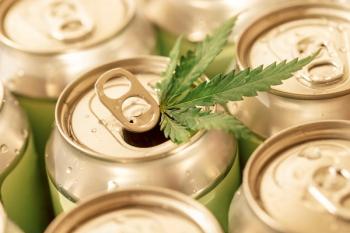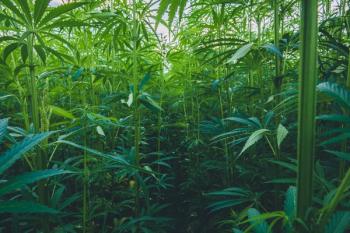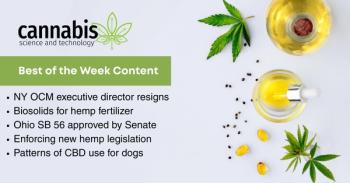
Cannabis Science and Technology
- June 2020
- Volume 3
- Issue 5
Hope on the Hemp Testing Horizon

A proper set of hemp standard reference materials courtesy of the University of Kentucky are now available and the implications of this for hemp testing are discussed.
The lack of cannabis standard reference materials means the phenomenon of inter-laboratory error is still with us. This problem is so bad it means results from different laboratories should not be compared to each other. The good news is that their finally exists a proper set of hemp standard reference materials courtesy of the University of Kentucky. The implications of this for hemp testing are discussed.
The inter-laboratory error problem strikes again. Myself and others have researched and written extensively on that problem in the cannabis analysis industry (1–7). This problem occurs when different laboratories obtain markedly different results on the same samples. Unfortunately, the problem is still with us as seen in Tables I and II, which show the total tetrahydrocannabinol (THC) and total cannabidiol (CBD) measurements on a set of three hemp samples sent to two different laboratories.
Both laboratories S and N are fully state licensed, International Organization for Standardization (ISO) certified, and enjoy a good reputation in the cannabis industry. If we had the right level of standardization, these two laboratories would obtain the same results on the same samples within their margin of error (8). The results in Tables I and II clearly show this is not the case. The standard deviation for total THC between the two laboratories is 0.11 wt.%. This may seem small and acceptable. However, legal hemp cannot contain more than 0.3% total THC by dry weight (9,10), and the inter-laboratory error (standard deviation) of 0.11%, when divided into 0.3%, represents a relative error of 36.6%. This is way too large to be thought accurate. The inter-laboratory error is particularly acute for the sample C4 listed in Table I. Laboratory S found 0.33% total THC, while Laboratory N found 0.21% total THC. The difference of 0.12% means Laboratory S says the material is illegal, whereas Laboratory N says it is legal. Thus, the choice of laboratory determines whether a hemp farmer can sell their crop or not. Who are we to believe here?
The situation for total CBD measurements is worse, as seen in Table II. This value is used to determine hemp prices. The standard deviation between the two laboratories is 2.1 wt.% total CBD. This much of a difference can cost hemp farmers thousands of dollars when they go to sell their crop. Again, the choice of laboratories determines the success or failure of the hemp farmer. Who are we to believe? The livelihood of thousands of farmers, and millions of dollars, are at stake each harvest season, and depend upon the accuracy of these measurements. The ongoing problem of inter-laboratory error means that our cannabis testing regulatory framework is inadequate and needs to be fixed (6).
The inter-laboratory error problem has real world consequences whenever cannabis materials are bought and sold. Imagine a hemp deal where the total CBD value is going to determine the price. The seller may have a certificate of analysis for the material that says the total CBD is 7.54%, and the buyer may have the material analyzed at their laboratory which finds a total CBD value of 4.73%, a difference of 2.81%. This is exactly the case for sample Mountain Mango seen in Table II, so the problem is real. Whose value should be used to determine the sale price? A solution to this problem is for the buyer and seller to agree upon whose measurements they will trust prior to the transaction.
The Search for Cannabis Standard Reference Materials
One of the causes of inter-laboratory error is the lack of cannabis standard reference materials (SRMs) (5). This would be a set of samples whose composition the stakeholders in this industry can agree upon. These samples could then be used in round-robin studies to compare laboratories, ascertain method quality, and research new testing technologies.
In the United States the National Institutes of Standards and Technology (NIST) is the Federal agency tasked with generating SRMs for industry (11). For example, NIST supports the green tea industry with a standard reference material (12). This means NIST knows how to create SRMs for agricultural crops. It would make sense then that NIST would create SRMs for the cannabis industry. However, recall that at the Federal level all cannabis plant material with a total THC value of greater than 0.3% is considered marijuana and is illegal (9,10). Thus, it would be against Federal law for NIST to develop SRMs for marijuana analysis. But there is nothing preventing NIST from developing SRMs for legal hemp. They are in fact developing such materials (13). However, it may be some time before these SRMs are ready.
The lack of SRMs affects our ability to calculate accuracies in cannabis analysis. But first, we need to clarify how “accuracy” should be calculated for chromatographic cannabis potency measurements. Typically, chromatographs are calibrated for potency using solutions of cannabinoids of known concentration (14–16). This is appropriate because due to the sample preparation required for chromatography, the sample being injected into the chromatograph is a solution of cannabinoids. In this case, the true value comes from the known amounts of cannabinoids in the pure standards, and an accuracy calculation is possible. Impressive potency measurement accuracies are possible when analyzing pure cannabinoids (14–16).
The lack of appropriate SRMs makes it impossible to calculate a true accuracy value for real cannabis samples. This is why I say the concept of accuracy is a myth in cannabis analysis. This, combined with variations in method across laboratories, is why you can’t compare numbers across laboratories. The inter-laboratory error, documented for example in Tables I and II, is too large.
At the end of the day the problem isn’t that one laboratory’s method is “right” and some other laboratory’s method is “wrong.” The problem is that the lack of SRMs and standardization means that no two laboratories use the same exact methods, which means no two laboratories are going to get the exact same result on the same samples.
This does not mean precision measurements cannot be made. Recall that precision is a measure of reproducibility (8). A laboratory could determine its method’s precision by analyzing multiple aliquots of the same sample and then comparing the results. This measurement, and not how well a method analyzes pure standards, is for now the best measure we have of cannabis analysis method quality.
Hope on the Hemp Testing Horizon
The search for a set of SRMs for hemp is over. The University of Kentucky (UKY) has developed a set of hemp standard reference materials as part of their Hemp Proficiency Program (HPP) (17). This sample set consists of four legal hemp samples, each of which has been analyzed by dozens of cannabis analysis laboratories across the country. The certificates of analysis that come with these samples contain the average total THC, total CBD, and other cannabinoid weight percents as determined by these laboratories.
I have vetted these SRMs by sending three aliquots of each sample for high performance liquid chromatography (HPLC) analysis to a laboratory I trust, SC Labs of Santa Cruz, Califronia (18). The purpose was to assess the homogeneity of the samples. The results for total THC are seen in Table III.
The difference between triplicate analyses of the same sample are in the third decimal place. This indicates the UKY hemp samples are homogeneous. This is impressive considering how inhomogeneous hemp plant material is, and how hard it is to render these samples uniform.
My other way of assessing the quality of the UKY samples was to see how well their values compared with those of SC Labs. The results for total THC are seen in Table IV.
Note that the differences are on the order of 0.03 wt.%. This excellent agreement convinces me that the weight percent cannabinoid values on the certificates of analysis that come with the UKY samples are correct.
This means we finally have an independent set of hemp SRMs-a set of hemp plant material samples with true cannabinoid content values. This sample set allows true accuracy calculations to be made, individual laboratories can evaluate their methods by comparing themselves to true standards, inter-laboratory round-robin studies can be performed to evaluate different methods, and a sample set exists with which to compare results from new testing technologies (19).
I strongly encourage all cannabis testing laboratories in the US interested in testing hemp to analyze this sample set, and participate in the University of Kentucky’s Hemp Proficiency Program (17).
Conclusions
The problem of inter-laboratory error continues to plague the cannabis analysis industry. This makes it difficult, for example, to set the purchase price for cannabis materials. A part of the problem is the lack of cannabis standard reference materials. Fortunately, the University of Kentucky has developed a set of hemp validation samples as part of their Hemp Proficiency Program. I have vetted these samples and am convinced they are legitimate. The hemp testing industry should be using these samples in round robin studies to ascertain method and laboratory quality, and develop new and better cannabis analysis methods.
References
- B.C. Smith, P. Lessard, and R. Pearson, Cannabis Science and Technology2(1), 48–53 (2019).
- M.O. Bonn-Miller, M.J.E. Loflin, B.F. Thomas, J.P. Marcu, T. Hyke, and R. Vandrey, JAMA, J. Am. Med. Assoc. 318, 1708 (2017).
- B. Young, The Seattle Times, January 5, 2016.
https://www.seattletimes.com/seattle-news/marijuana/some-pot-labs-in-state-failed-no-pot-at-all-says-scientist/ . https://www.nbcbayarea.com/investigations/Industry-Insiders-Warn-of-Fraud-at-Marijuana-Testing-Labs-458125743.html?_osource=SocialFlowFB_BAYBrand .- B.C. Smith, Cannabis Science and Technology2(2), 12–17 (2019).
- B.C. Smith, Cannabis Science and Technology2(3), 10–14 (2019).
- B.C. Smith, Cannabis Science and Technology3(2), 10–15 (2020).
- B.C. Smith, Cannabis Science and Technology1(4), 12–16 (2018).
- 115th United States Congress, Senate Bill S.2667, ”Hemp Farming Act of 2018.”
https://www.federalregister.gov/documents/2019/10/31/2019-23749/establishment-of-a-domestic-hemp-production-program. www.nist.gov .https://www.nist.gov/publications/development-and-certification-green-tea-containing-standard-reference-materials .https://www.nist.gov/programs-projects/nist-tools-cannabis-laboratory-quality-assurance .- M.W. Giese, M.A. Lewis, L. Giese, and K.M. Smith, J. AOAC Int.98(6), 1503 (2015).
- C. Giroud, CHIMIA Intl. Journal of Chemistry56, 80 (2002).
- T. Ruppel and M. Kuffel, “Cannabis Analysis: Potency Testing Identification and Quantification of THC and CBD by GC/FID and GC/MS,” PerkinElmer Application Note, 2013.
http://www.rs.uky.edu/regulatory/hpt/ .www.sclabs.com .- B.C. Smith, Cannabis Science and Technology2(6), 28–33 (2019).
About the Columnist
Brian C. Smith, PhD, is Founder, CEO, and Chief Technical Officer of Big Sur Scientific. He is the inventor of the BSS series of patented mid-infrared based cannabis analyzers. Dr. Smith has done pioneering research and published numerous peer-reviewed papers on the application of mid-infrared spectroscopy to cannabis analysis, and sits on the editorial board of Cannabis Science and Technology. He has worked as a lab director for a cannabis extractor, as an analytical chemist for Waters Associates and PerkinElmer, and as an analytical instrument salesperson. He has more than 30 years of experience in chemical analysis and has written three books on the subject. Dr. Smith earned his PhD on physical chemistry from Dartmouth College.
How to Cite this Article
B. Smith, Cannabis Science and Technology 3(5), 10-13 (2020).
Articles in this issue
over 5 years ago
Everything Old is New Again: Cannabis Returns to USPover 5 years ago
A Tribute to the Life and Legacy of Charlotte Figiover 5 years ago
A Chemist’s Guide to the COVID-19 Outbreakover 5 years ago
Spring 2020 CANN Virtual Symposium Meeting ReportNewsletter
Unlock the latest breakthroughs in cannabis science—subscribe now to get expert insights, research, and industry updates delivered to your inbox.




